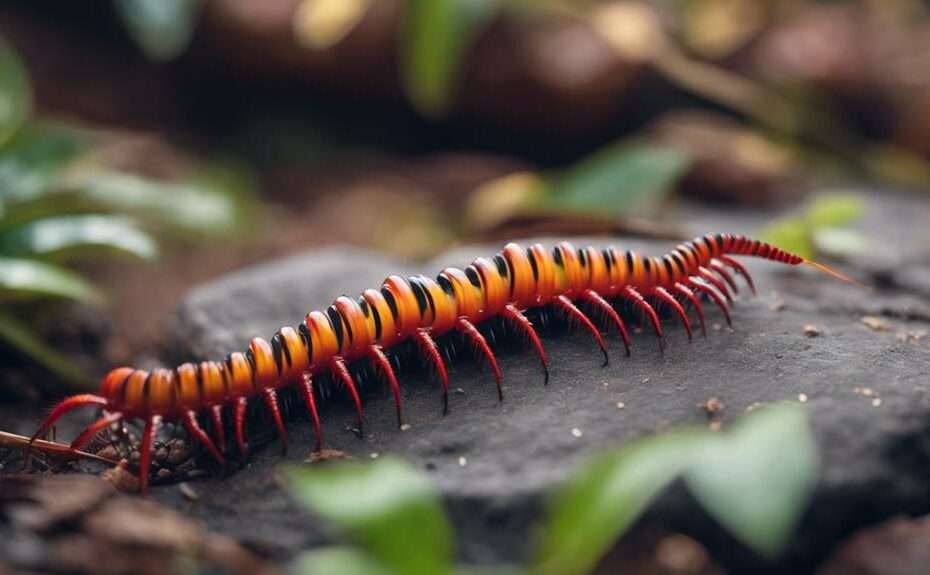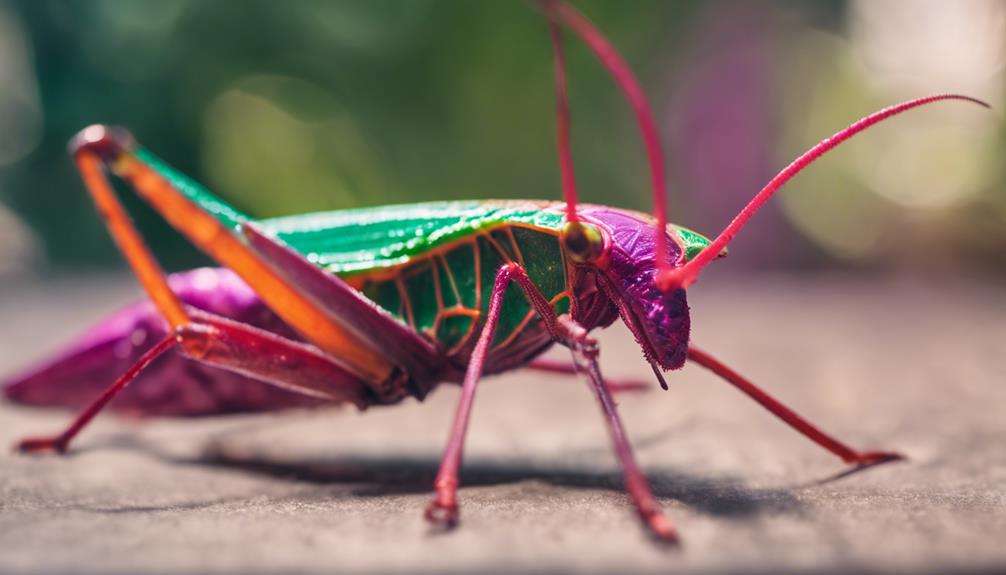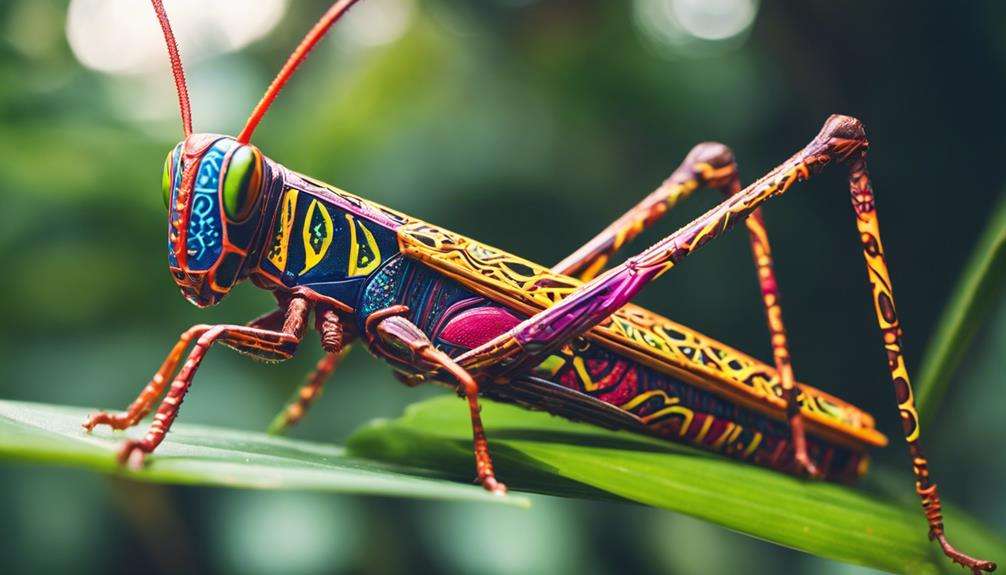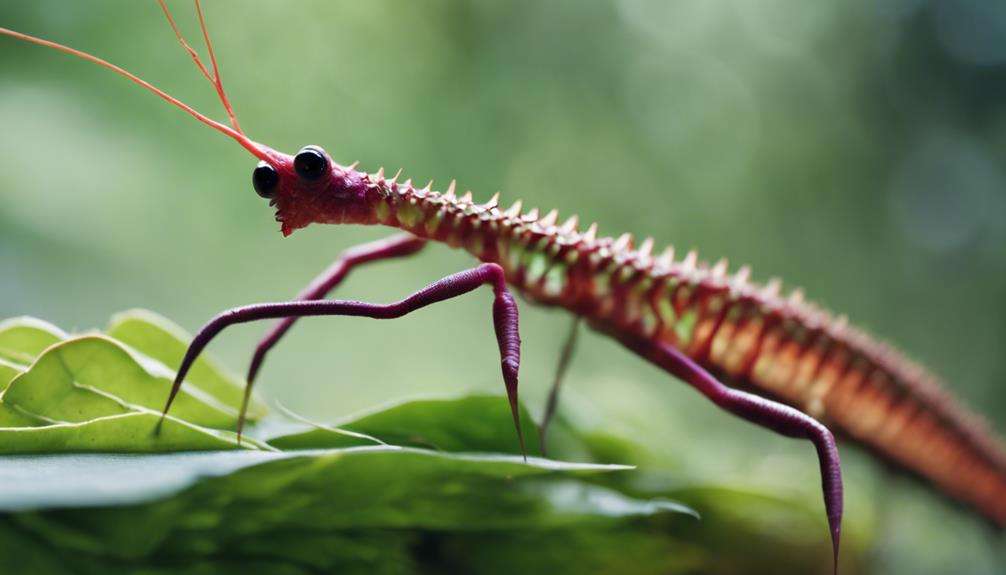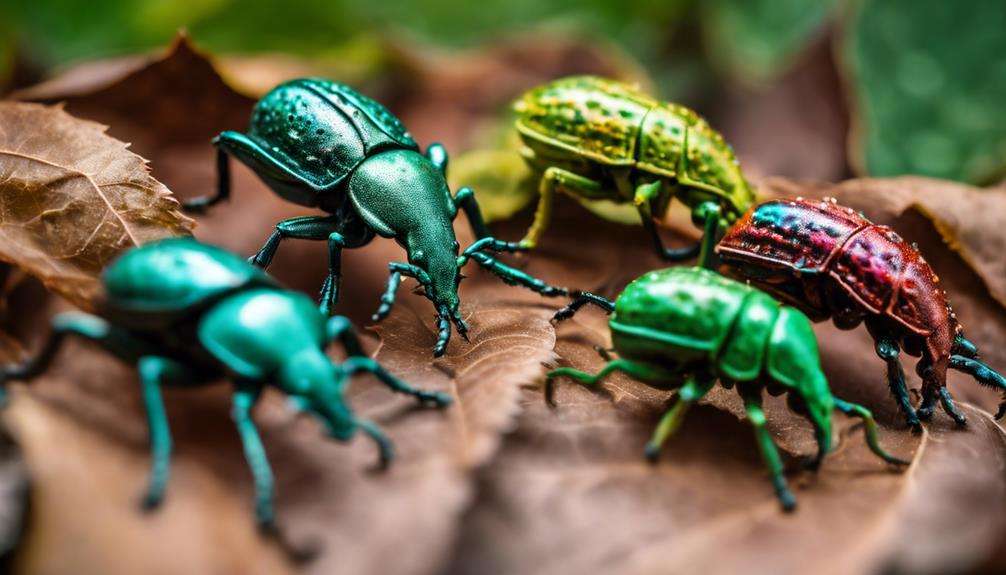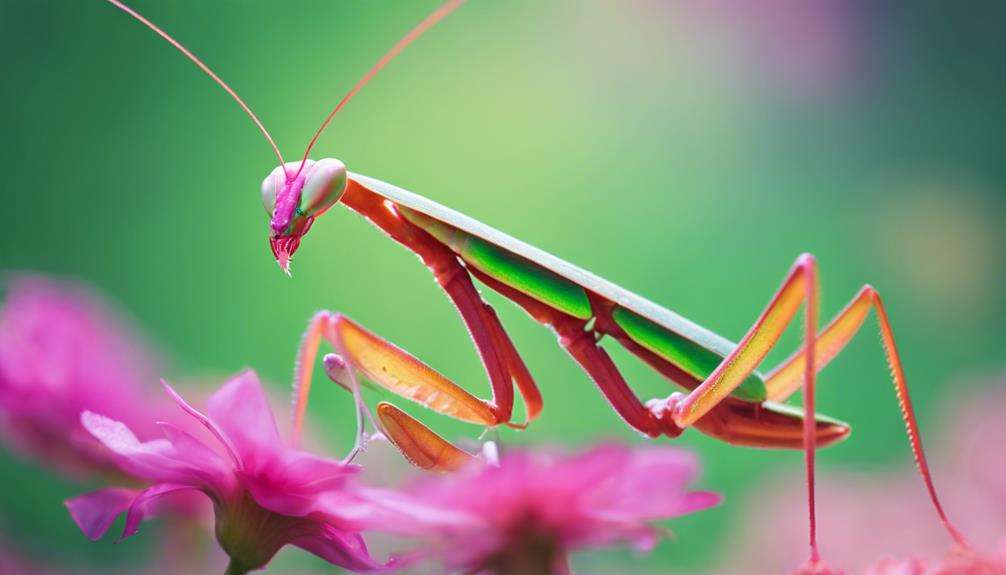Imagine your unconventional pet collection as a mysterious puzzle, where each piece is a fascinating centipede waiting to be uncovered. With their cryptic movements and intriguing habits, these creatures offer a glimpse into a hidden world often overlooked.
As you explore the diverse species and their captivating behaviors, you will soon realize that centipedes hold secrets that may surprise even the most seasoned pet enthusiasts. Their enigmatic nature invites you to unravel the mysteries they conceal, making them a compelling addition to your collection.
Key Takeaways
- Chinese Redheaded Centipede has unique physical features and behavior.
- Blue Centipedes require specific terrarium setups for optimal care.
- Vietnamese Centipedes and Giant Tropical Centipedes have distinct care needs.
- House Centipedes and Tiger Centipedes exhibit interesting characteristics and traits.
Brown Centipede
Brown Centipedes, scientifically referred to as Lithobius forficatus, thrive in garden environments, actively foraging under stones year-round. These house centipedes, reaching lengths of up to one inch, are popular among beginners due to their manageable size and non-harmful venomous claws. Their preference for living underground makes them less suitable for display in pet enclosures. Despite this, their small size and low aggression levels make them an excellent choice for novice owners interested in caring for an invertebrate pet.
As efficient predators, Brown Centipedes play a crucial role in natural pest control by feeding on insects. Their nocturnal nature and preference for dark, damp environments contribute to their success as hunters. Observing a Brown Centipede in its natural habitat can provide valuable insights into its behavior and feeding habits. Overall, these creatures offer an intriguing glimpse into the world of invertebrates and the important role they play in maintaining ecological balance.
Chinese Redheaded Centipede
The Chinese Redheaded Centipede, Scolopendra subspinipes mutilans, is distinguished by its vibrant red head and sleek, segmented body.
These centipedes are primarily found in East Asia and Australasia, favoring moist habitats such as forests and caves.
Observing their hunting behavior and interactions within their environment provides valuable insights into their unique adaptation strategies.
Unique Physical Features
Unveil the intricate physical features of the Chinese Redheaded Centipede, *Scolopendra subspinipes mutilans*, found in East Asia and Australasia. This fascinating centipede exhibits:
- Venomous Adaptations: The Chinese Redheaded Centipede possesses venom glands in its forcipules, specialized legs located near its head, allowing it to inject potent venom into its prey.
- Unusual Appendages: With its elongated body covered in segments, each bearing a pair of legs, this centipede showcases distinctive red head coloration, contrasting with its dark body.
- Intriguing Locomotion Techniques: Utilizing its numerous legs in a wave-like motion, the Chinese Redheaded Centipede moves swiftly across its environment, displaying agility and speed in capturing prey.
Habitat and Behavior
With a preference for damp environments, Chinese Redheaded Centipedes, scientifically known as Scolopendra subspinipes mutilans, exhibit intriguing behaviors that reflect their adaptability and hunting prowess. These centipedes showcase unique nesting habits, often creating burrows in moist soil or under rocks to seek shelter and lay eggs. Their mating rituals involve elaborate dances and pheromone signals to attract potential partners.
While not aggressive towards their own kind, they display territorial behavior, marking their territories with pheromones to establish boundaries. Chinese Redheaded Centipedes also benefit from environmental enrichment, such as providing hiding spots and varied substrates in captivity. Their dietary preferences include live insects like crickets and mealworms, reflecting their carnivorous nature and predatory instincts.
Care and Feeding
When caring for the Chinese Redheaded Centipede, ensure to provide a suitable habitat that mimics their natural damp environment to support their well-being and behavior. These centipedes require a terrarium with substrate for burrowing and hiding spots, maintaining humidity levels between 75-85%.
Here are some care tips:
- Feeding schedule, enclosure setup
- Feed your centipede appropriately sized live prey, such as crickets or mealworms, every 7-10 days.
- Ensure the enclosure has secure lids and escape-proof barriers due to their escape artist tendencies.
- Clean the enclosure regularly to prevent mold growth and maintain a healthy environment.
Remember to handle them with care to avoid bites, watch for signs of dehydration or stress, and consider providing enrichment through varied hiding spots and occasional misting for hydration.
Fuzzy Centipede
Observing the Fuzzy Centipede, also known as Scutigera coleoptrata, reveals a small arthropod with distinctive yellowish coloring and long, delicate legs.
When it comes to breeding habits, Fuzzy Centipedes reproduce by laying eggs in hidden, humid areas. It's crucial to provide a suitable environment with ample moisture to support successful breeding.
Handling these centipedes requires caution due to their fragile legs, so it's advisable to gently scoop them up using a soft brush or container to avoid harming them. Always wash your hands thoroughly after handling to prevent any potential skin irritation.
In terms of health concerns, Fuzzy Centipedes are generally hardy creatures but may be susceptible to stress if their habitat isn't adequately maintained. Ensure they have access to water and small prey to maintain their well-being.
Vietnamese Centipedes
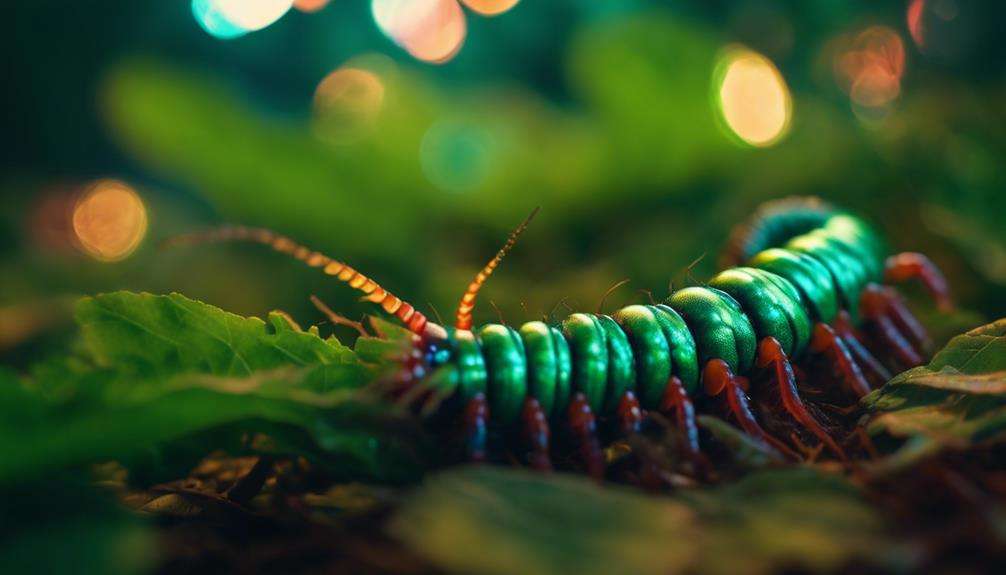
Vietnamese Centipedes, scientifically known as Scolopendra subspinipes, are fascinating creatures with dark reddish-brown bodies and light orange legs that can grow up to 10 inches in length. Their habitat in tropical and subtropical regions makes them challenging for novice keepers due to their quick, aggressive behavior and nervous disposition.
When considering Vietnamese Centipedes for your collection, it's crucial to understand their unique care requirements and the importance of expert handling to ensure their well-being.
Vietnamese Centipede Habitat
In the natural environment, Scolopendra subspinipes, commonly known as Vietnamese Centipedes, thrive in habitats that replicate their tropical and subtropical origins.
- Vietnamese centipede terrarium setup:
- Provide a terrarium with plenty of hiding spots like rocks and bark.
- Ensure a substrate of coconut fiber or peat moss for burrowing.
- Include branches or cork bark for climbing.
Maintain an optimal temperature and humidity:
- Keep the terrarium temperature between 75-85°F.
- Maintain humidity levels around 70-85%.
- Use a heat mat or ceramic heat emitter for warmth.
Choose suitable tank mates carefully:
- Avoid housing them with other centipedes or aggressive species.
- Opt for peaceful tank mates like certain species of snails or isopods.
- Ensure tank mates have similar environmental requirements to prevent stress.
Vietnamese Centipede Care
To ensure the proper care of Vietnamese Centipedes, meticulous attention to their unique requirements is essential. Handling challenges arise due to their aggressive behavior and venomous nature. These centipedes, known as Scolopendra subspinipes, can reach lengths of up to 10 inches, featuring a dark reddish-brown body with light orange legs.
Their nervous and fast nature makes them challenging for beginners to manage. Their potent venom can cause painful stings, emphasizing the need for experienced owners. Vietnamese Centipedes are smart, agile predators that feed on animals like birds and snakes.
Proper care and handling protocols are crucial to mitigate the risks associated with their aggressive behavior and venomous capabilities.
Blue Centipedes
Blue Centipedes, known scientifically as Hemiscolopendra Marginata, can reach impressive lengths of up to 9 inches and display a striking color palette ranging from greenish-yellow to dark blue. These colorful centipede species are fascinating additions to any unconventional pet collection.
When considering Blue Centipedes for your terrarium, there are several essential factors to keep in mind:
- Terrarium Setup Tips:
- Provide a substrate that retains moisture well, like coconut fiber.
- Include hiding spots such as cork bark or small logs for the centipede to burrow and feel secure.
- Maintain a temperature range between 75-85°F with moderate humidity levels.
Due to their nervous and aggressive nature, handling precautions are crucial when dealing with Blue Centipedes. These creatures are best observed from a distance due to their venom risks and defensive behavior. Remember that a hands-off approach is advisable to ensure both your safety and the well-being of the centipede.
Giant Red-headed Centipedes
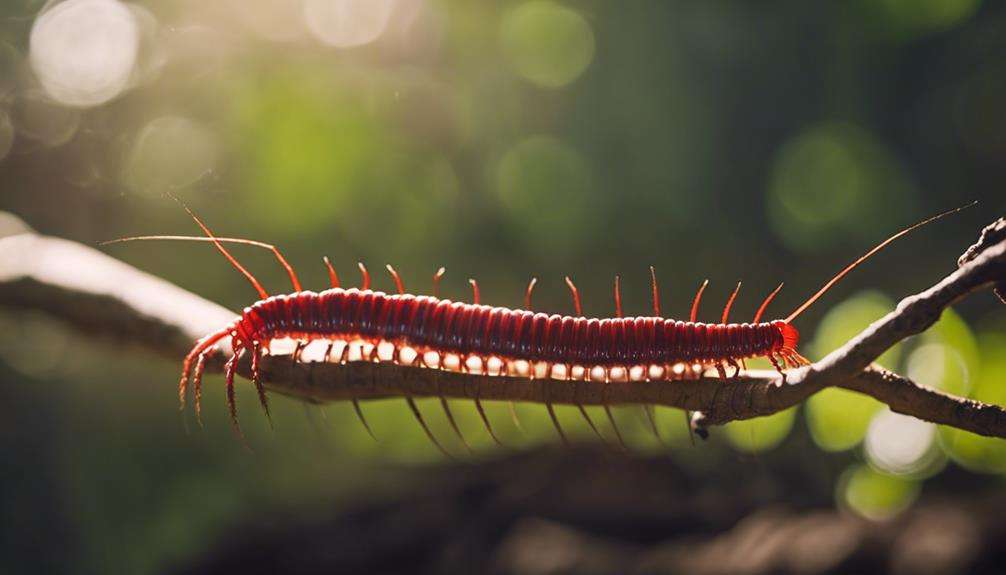
Giant Red-headed Centipedes, also known as Scolopendra heros, exhibit fascinating behavior worth exploring.
Their striking red heads and long bodies captivate observers.
Understanding their care requirements and unique features can enhance your experience with these intriguing creatures.
Red-Headed Centipede Behavior
In their natural habitat, the behavior of the Red-Headed Centipede, specifically the Giant Red-headed Centipedes (Scolopendra heros), reflects their aggressive predatory nature and venomous capabilities.
Red Headed Centipede Mating Behaviors
Giant Red-headed Centipedes engage in elaborate courtship rituals involving pheromones and tactile communication to attract mates.
Red Headed Centipede Hunting Strategies
These centipedes use their speed and venomous bite to overpower prey, often hunting at night to surprise their victims.
Red Headed Centipede Defensive Mechanisms
When threatened, Giant Red-headed Centipedes can rear up, displaying their fangs and warning predators with their bright coloration, while also releasing a noxious odor to deter potential threats.
Care Tips for Centipedes
Care tips for Giant Red-headed Centipedes include providing a suitable habitat with ample hiding spots and maintaining a consistent humidity level to support their well-being and natural behavior. Due to their venomous nature, handling precautions must be strictly adhered to.
When caring for these venomous species, safety measures should be a priority to prevent any health risks. Expert care and specialized knowledge are essential for the proper maintenance of Giant Red-headed Centipedes. It's crucial to understand their behaviors and habitat requirements thoroughly.
Always approach these centipedes with caution and respect their space to avoid any potential dangers associated with their toxic venom. Advanced handling techniques and a deep understanding of their needs are necessary for successful care.
Unique Features of Centipedes
With striking red heads and formidable venom, the Scolopendra heros centipedes exhibit unique features that demand careful attention and respect in their care and handling. These Giant Red-headed Centipedes possess fascinating characteristics that set them apart from other species:
- Centipede Anatomy: Giant Red-headed Centipedes can reach lengths of up to 12 inches, making them one of the largest centipede species. Their bright red heads and multi-segmented bodies make them visually striking.
- Venomous Species: When provoked, these centipedes can deliver a painful toxin through their bites. Their venom is potent and primarily used for subduing prey such as lizards, snakes, and toads.
- Unusual Behaviors: Giant Red-headed Centipedes exhibit unique hunting techniques, actively seeking out their prey with impressive speed and agility. They're known for their voracious appetite and predatory skills, making them fascinating yet potentially dangerous creatures to handle.
Giant Tropical Centipedes
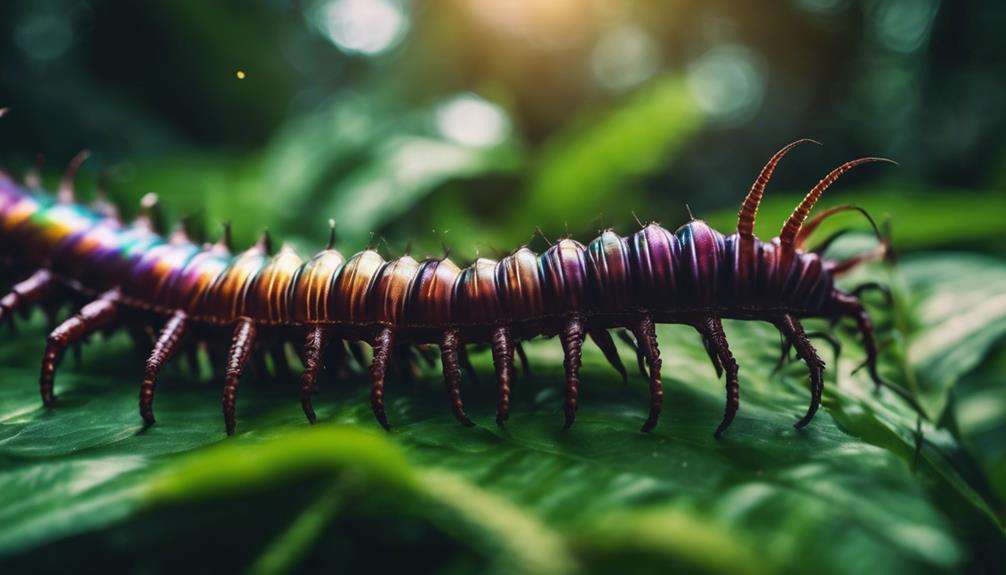
Measuring up to 12 inches in length, the Giant Tropical Centipedes, scientifically known as Scolopendra Gigantea, are formidable predators found in tropical and subtropical regions. Handling these centipedes requires caution and expertise due to their venomous bite. Research on centipede venom is crucial for understanding its effects and developing potential antivenom treatments. However, breeding these centipedes poses significant challenges due to their aggressive nature and cannibalistic tendencies towards their own kind.
Centipede handling techniques for Giant Tropical Centipedes involve using specialized tools like long forceps to avoid direct contact. When interacting with these centipedes, it's vital to move slowly and deliberately to prevent startling them, reducing the risk of defensive behavior. Venom research on these centipedes focuses on analyzing the composition of their venom to determine its potency and effects on different species. Understanding centipede venom can provide valuable insights into developing treatments for envenomation cases.
Breeding Giant Tropical Centipedes in captivity is complex due to their solitary nature and tendency to attack potential mates. Overcoming these challenges requires careful monitoring and providing suitable environments to encourage successful reproduction.
Arizona House Centipede
The distinctive orange coloration and yellow spots of the Arizona House Centipede make it easily distinguishable within its native habitat in the Southwest USA.
- Centipede Anatomy:
The Arizona House Centipede, scientifically known as Dendrothereua homa, showcases segmented bodies with one pair of legs per segment, culminating in a remarkable speed and agility for hunting.
- Reproductive Habits:
Mating in these centipedes involves a fascinating ritual where the male deposits a spermatophore for the female to pick up with her genital openings. This process ensures successful fertilization for reproduction.
- Defensive Mechanisms:
When threatened, Arizona House Centipedes exhibit defensive behaviors such as fast movements to escape predators. Additionally, they possess venomous claws that assist in subduing prey and deterring potential threats.
Observing the intricate centipede anatomy, reproductive habits, and defensive mechanisms of the Arizona House Centipede provides insight into the complexity and adaptability of these unique creatures.
Tanzanian Blue Leg Centipede
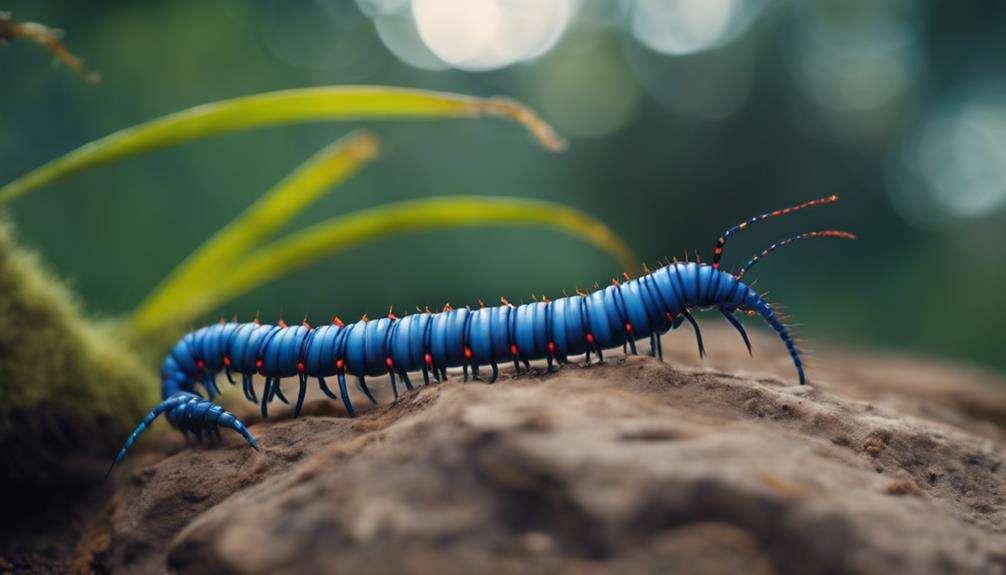
Inhabiting the savannah terrariums of Tanzania, the Tanzanian Blue Leg Centipede, Hemiscolopendra Marginata, showcases a striking array of colors ranging from greenish-yellow to dark blue. These centipedes can reach lengths of up to 9 inches, displaying a visually captivating appearance.
Renowned for their nervous and aggressive tendencies, they often burrow in their natural habitats. Due to their venomous capabilities and size, they're more suited for experienced pet owners. When handling the Tanzanian Blue Leg Centipede, it's important to exercise caution due to their speed and agility.
Their breeding habits involve the female laying eggs in soil or other suitable substrates, with the young centipedes resembling miniature versions of the adults. The venom of these centipedes is potent and primarily used for subduing prey, so it's advisable to avoid direct contact to prevent any potential harm.
Amazonian Giant Centipede
With a formidable reputation in the realm of arthropods, the Amazonian Giant Centipede commands attention with its imposing size and predatory prowess. This species, scientifically known as Scolopendra gigantea, can reach lengths of up to 12 inches, making it one of the largest centipedes in the world.
When considering this centipede for your collection, be aware of the challenges it presents:
- Handling challenges: Due to its venomous nature and quick movements, interacting with the Amazonian Giant Centipede requires caution and experience.
- Venomous nature: This centipede preys on animals as large as birds and snakes, possessing venom that can be harmful to humans, especially children.
- Colorful appearance: Found in tropical and subtropical regions, the Amazonian Giant Centipede showcases a striking color palette of dark reddish-brown bodies and light orange legs, adding to its allure but also serving as a warning of its potential danger.
Frequently Asked Questions
Can Centipedes Be Kept as Pets?
Yes, centipedes can be kept as pets. They require specific care requirements like a secure enclosure, proper substrate, and regular misting. When handling, be cautious due to their venomous bite. They are carnivorous feeders, preying on insects and spiders.
Do Centipedes Like Their Owners?
Centipedes do not like their owners; their behavior is driven by survival instincts. Interactions with humans are based on needs for food and shelter, not emotional connection. Providing a suitable environment is crucial for centipedes' well-being.
What Are the Rare Types of Centipedes?
Rare centipedes exhibit unusual habitats, unique behaviors, and exotic care requirements. Chinese Redheaded Centipedes, found in East Asia and Australasia, are suitable for beginners. They have low aggression, manageable size, and make intriguing additions to your collection.
Are Centipedes Friendly to Humans?
Centipedes' behavior leans toward aggression, not friendliness, due to their venomous claws. Handling them requires caution to prevent painful stings. Care for centipedes means understanding their nature to ensure both their well-being and your safety.
Conclusion
In conclusion, the world of centipedes is a mesmerizing realm filled with diverse and captivating species that will leave you in awe. From the Brown Centipede to the Amazonian Giant Centipede, each one offers a unique glimpse into the wonders of nature.
So, if you're looking to add a touch of intrigue and excitement to your unconventional pet collection, look no further than these fascinating creatures that will surely keep you on the edge of your seat!
